5G Internet's Potential Disruption of the Insurance Industry
VerifiedAdded on 2023/04/26
|9
|1724
|252
Report
AI Summary
This report investigates the potential impact of 5G wireless technology on the insurance industry. It begins by researching the technology and the industry, highlighting the importance of customer engagement and high-speed data transmission. The report then brainstorms the potential influences of 5G, such as easier updates of insurance portals, commercial opportunities from reduced bandwidth specifications, and the implementation of innovative business strategies. Parallels are drawn to other industries like manufacturing, healthcare, and automotive. The report also discusses the use of other technologies in the insurance industry, such as chatbots, virtual reality, and artificial intelligence. It evaluates the impact of 5G on new business opportunities using Lawrence Lessig’s regulation model, considering market trends, laws, physical improvements, and ethical issues like the impact on migratory birds. The report identifies disrupted processes, process factors, events, activities, decision points, actors, and outcomes, emphasizing the positive impact of 5G on both internal and external stakeholders. Finally, a process model diagram illustrates data retrieval from official portals using 5G.
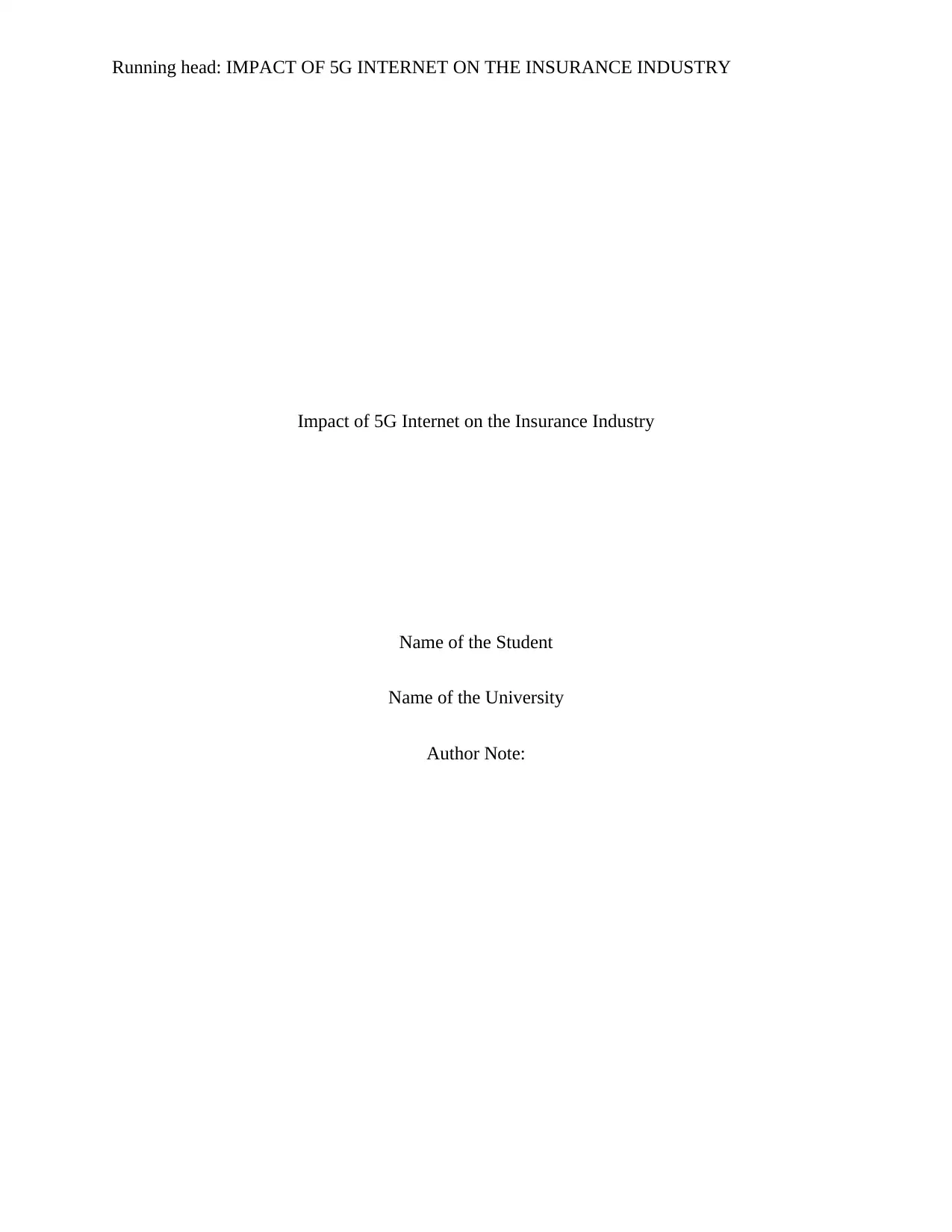
Running head: IMPACT OF 5G INTERNET ON THE INSURANCE INDUSTRY
Impact of 5G Internet on the Insurance Industry
Name of the Student
Name of the University
Author Note:
Impact of 5G Internet on the Insurance Industry
Name of the Student
Name of the University
Author Note:
Paraphrase This Document
Need a fresh take? Get an instant paraphrase of this document with our AI Paraphraser
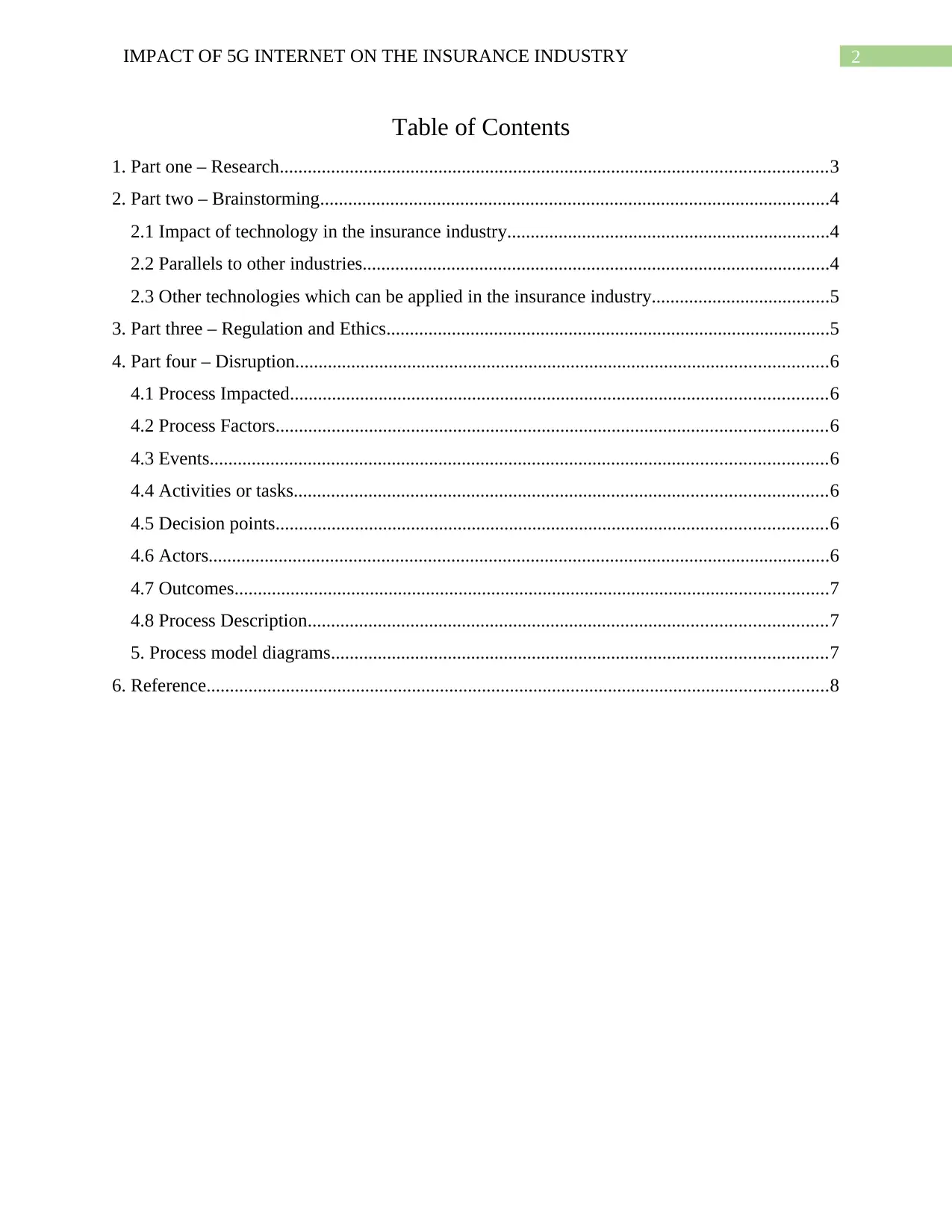
2IMPACT OF 5G INTERNET ON THE INSURANCE INDUSTRY
Table of Contents
1. Part one – Research.....................................................................................................................3
2. Part two – Brainstorming.............................................................................................................4
2.1 Impact of technology in the insurance industry.....................................................................4
2.2 Parallels to other industries....................................................................................................4
2.3 Other technologies which can be applied in the insurance industry......................................5
3. Part three – Regulation and Ethics...............................................................................................5
4. Part four – Disruption..................................................................................................................6
4.1 Process Impacted...................................................................................................................6
4.2 Process Factors......................................................................................................................6
4.3 Events....................................................................................................................................6
4.4 Activities or tasks..................................................................................................................6
4.5 Decision points......................................................................................................................6
4.6 Actors.....................................................................................................................................6
4.7 Outcomes...............................................................................................................................7
4.8 Process Description...............................................................................................................7
5. Process model diagrams..........................................................................................................7
6. Reference.....................................................................................................................................8
Table of Contents
1. Part one – Research.....................................................................................................................3
2. Part two – Brainstorming.............................................................................................................4
2.1 Impact of technology in the insurance industry.....................................................................4
2.2 Parallels to other industries....................................................................................................4
2.3 Other technologies which can be applied in the insurance industry......................................5
3. Part three – Regulation and Ethics...............................................................................................5
4. Part four – Disruption..................................................................................................................6
4.1 Process Impacted...................................................................................................................6
4.2 Process Factors......................................................................................................................6
4.3 Events....................................................................................................................................6
4.4 Activities or tasks..................................................................................................................6
4.5 Decision points......................................................................................................................6
4.6 Actors.....................................................................................................................................6
4.7 Outcomes...............................................................................................................................7
4.8 Process Description...............................................................................................................7
5. Process model diagrams..........................................................................................................7
6. Reference.....................................................................................................................................8
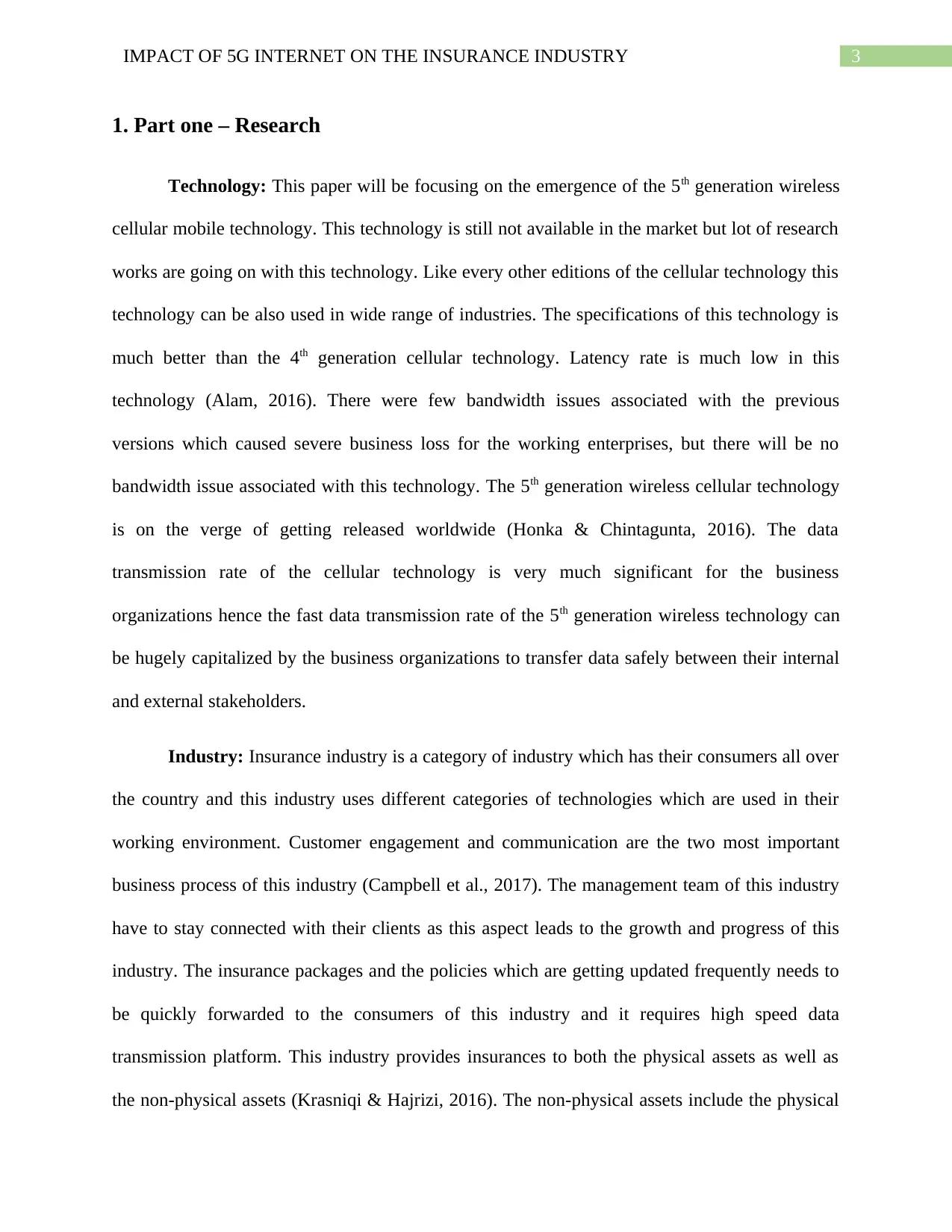
3IMPACT OF 5G INTERNET ON THE INSURANCE INDUSTRY
1. Part one – Research
Technology: This paper will be focusing on the emergence of the 5th generation wireless
cellular mobile technology. This technology is still not available in the market but lot of research
works are going on with this technology. Like every other editions of the cellular technology this
technology can be also used in wide range of industries. The specifications of this technology is
much better than the 4th generation cellular technology. Latency rate is much low in this
technology (Alam, 2016). There were few bandwidth issues associated with the previous
versions which caused severe business loss for the working enterprises, but there will be no
bandwidth issue associated with this technology. The 5th generation wireless cellular technology
is on the verge of getting released worldwide (Honka & Chintagunta, 2016). The data
transmission rate of the cellular technology is very much significant for the business
organizations hence the fast data transmission rate of the 5th generation wireless technology can
be hugely capitalized by the business organizations to transfer data safely between their internal
and external stakeholders.
Industry: Insurance industry is a category of industry which has their consumers all over
the country and this industry uses different categories of technologies which are used in their
working environment. Customer engagement and communication are the two most important
business process of this industry (Campbell et al., 2017). The management team of this industry
have to stay connected with their clients as this aspect leads to the growth and progress of this
industry. The insurance packages and the policies which are getting updated frequently needs to
be quickly forwarded to the consumers of this industry and it requires high speed data
transmission platform. This industry provides insurances to both the physical assets as well as
the non-physical assets (Krasniqi & Hajrizi, 2016). The non-physical assets include the physical
1. Part one – Research
Technology: This paper will be focusing on the emergence of the 5th generation wireless
cellular mobile technology. This technology is still not available in the market but lot of research
works are going on with this technology. Like every other editions of the cellular technology this
technology can be also used in wide range of industries. The specifications of this technology is
much better than the 4th generation cellular technology. Latency rate is much low in this
technology (Alam, 2016). There were few bandwidth issues associated with the previous
versions which caused severe business loss for the working enterprises, but there will be no
bandwidth issue associated with this technology. The 5th generation wireless cellular technology
is on the verge of getting released worldwide (Honka & Chintagunta, 2016). The data
transmission rate of the cellular technology is very much significant for the business
organizations hence the fast data transmission rate of the 5th generation wireless technology can
be hugely capitalized by the business organizations to transfer data safely between their internal
and external stakeholders.
Industry: Insurance industry is a category of industry which has their consumers all over
the country and this industry uses different categories of technologies which are used in their
working environment. Customer engagement and communication are the two most important
business process of this industry (Campbell et al., 2017). The management team of this industry
have to stay connected with their clients as this aspect leads to the growth and progress of this
industry. The insurance packages and the policies which are getting updated frequently needs to
be quickly forwarded to the consumers of this industry and it requires high speed data
transmission platform. This industry provides insurances to both the physical assets as well as
the non-physical assets (Krasniqi & Hajrizi, 2016). The non-physical assets include the physical
⊘ This is a preview!⊘
Do you want full access?
Subscribe today to unlock all pages.

Trusted by 1+ million students worldwide
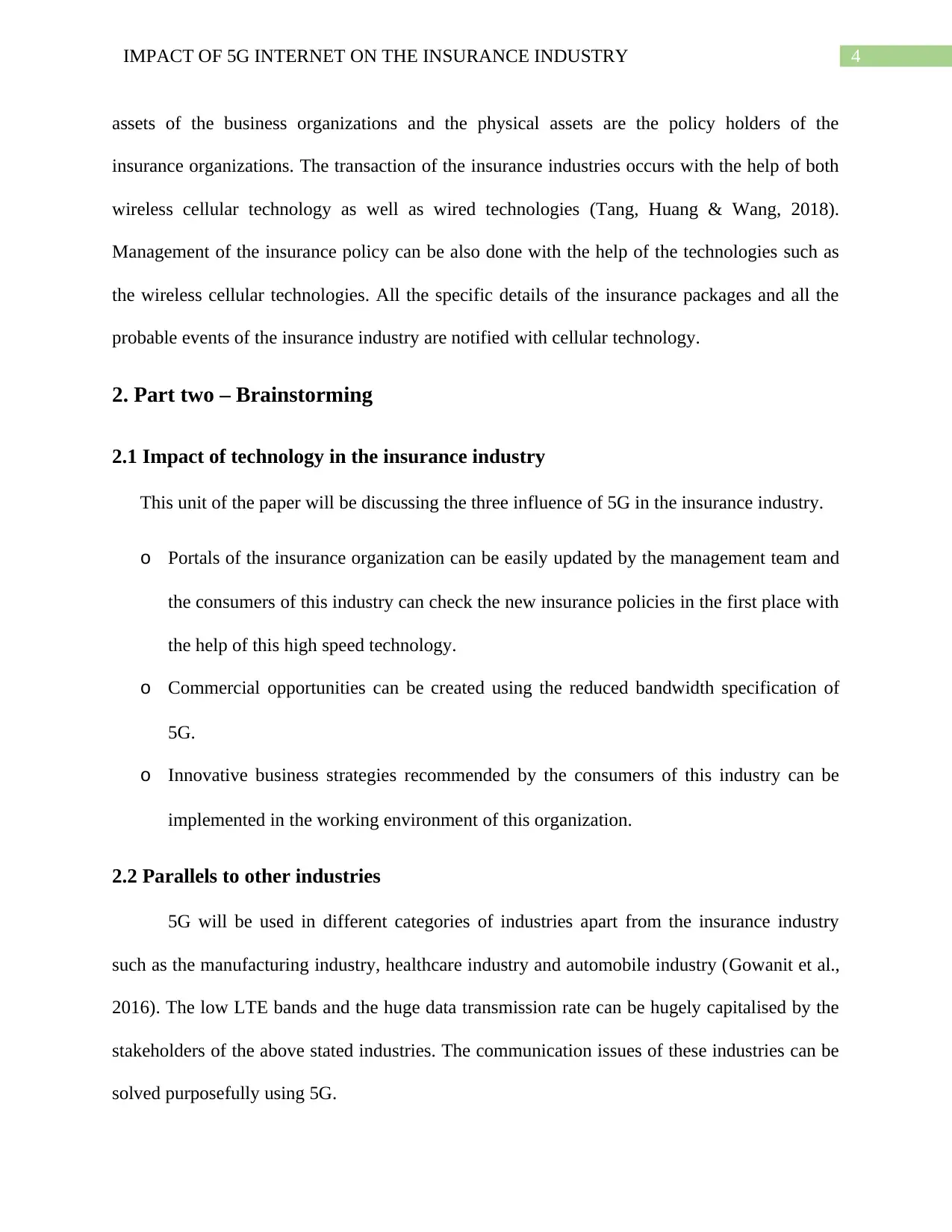
4IMPACT OF 5G INTERNET ON THE INSURANCE INDUSTRY
assets of the business organizations and the physical assets are the policy holders of the
insurance organizations. The transaction of the insurance industries occurs with the help of both
wireless cellular technology as well as wired technologies (Tang, Huang & Wang, 2018).
Management of the insurance policy can be also done with the help of the technologies such as
the wireless cellular technologies. All the specific details of the insurance packages and all the
probable events of the insurance industry are notified with cellular technology.
2. Part two – Brainstorming
2.1 Impact of technology in the insurance industry
This unit of the paper will be discussing the three influence of 5G in the insurance industry.
o Portals of the insurance organization can be easily updated by the management team and
the consumers of this industry can check the new insurance policies in the first place with
the help of this high speed technology.
o Commercial opportunities can be created using the reduced bandwidth specification of
5G.
o Innovative business strategies recommended by the consumers of this industry can be
implemented in the working environment of this organization.
2.2 Parallels to other industries
5G will be used in different categories of industries apart from the insurance industry
such as the manufacturing industry, healthcare industry and automobile industry (Gowanit et al.,
2016). The low LTE bands and the huge data transmission rate can be hugely capitalised by the
stakeholders of the above stated industries. The communication issues of these industries can be
solved purposefully using 5G.
assets of the business organizations and the physical assets are the policy holders of the
insurance organizations. The transaction of the insurance industries occurs with the help of both
wireless cellular technology as well as wired technologies (Tang, Huang & Wang, 2018).
Management of the insurance policy can be also done with the help of the technologies such as
the wireless cellular technologies. All the specific details of the insurance packages and all the
probable events of the insurance industry are notified with cellular technology.
2. Part two – Brainstorming
2.1 Impact of technology in the insurance industry
This unit of the paper will be discussing the three influence of 5G in the insurance industry.
o Portals of the insurance organization can be easily updated by the management team and
the consumers of this industry can check the new insurance policies in the first place with
the help of this high speed technology.
o Commercial opportunities can be created using the reduced bandwidth specification of
5G.
o Innovative business strategies recommended by the consumers of this industry can be
implemented in the working environment of this organization.
2.2 Parallels to other industries
5G will be used in different categories of industries apart from the insurance industry
such as the manufacturing industry, healthcare industry and automobile industry (Gowanit et al.,
2016). The low LTE bands and the huge data transmission rate can be hugely capitalised by the
stakeholders of the above stated industries. The communication issues of these industries can be
solved purposefully using 5G.
Paraphrase This Document
Need a fresh take? Get an instant paraphrase of this document with our AI Paraphraser
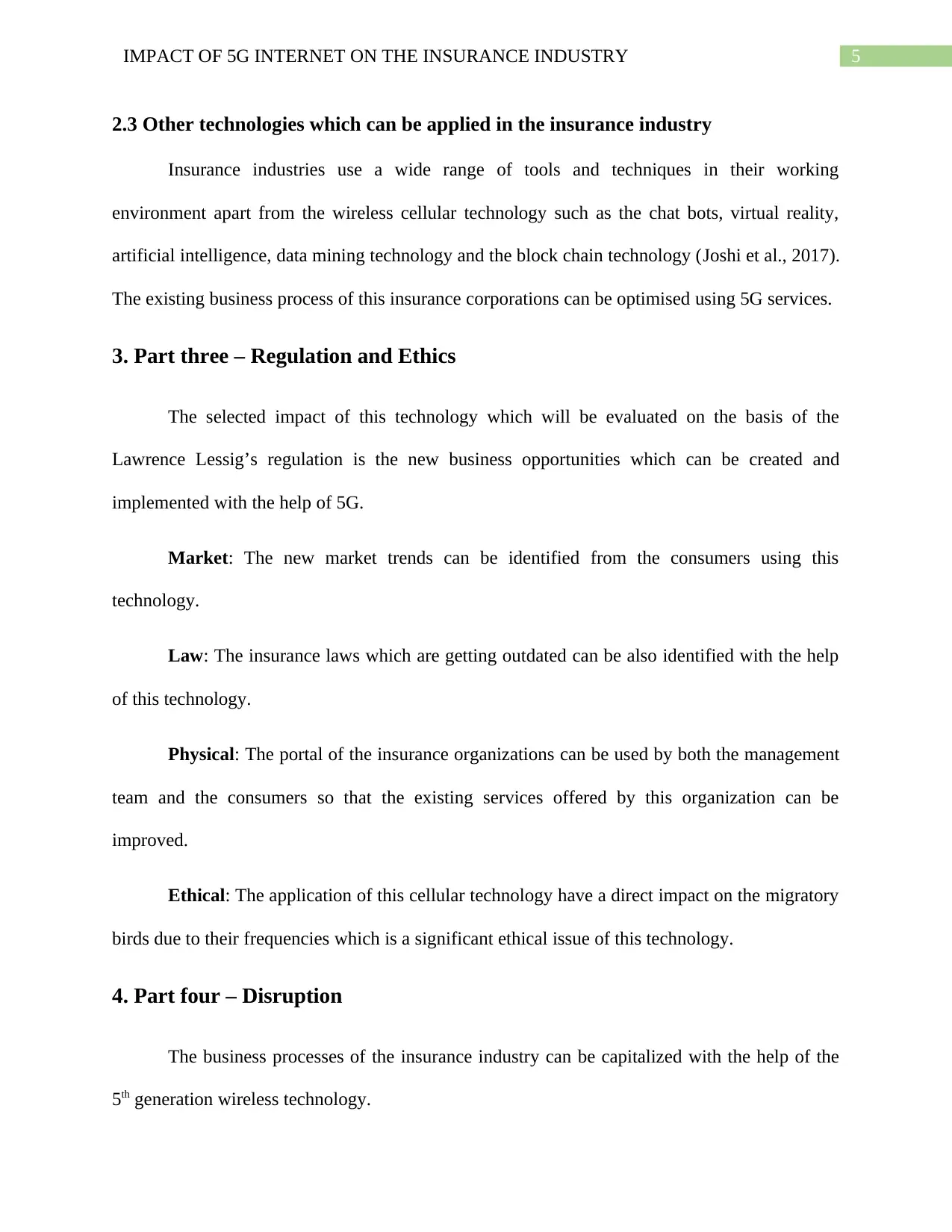
5IMPACT OF 5G INTERNET ON THE INSURANCE INDUSTRY
2.3 Other technologies which can be applied in the insurance industry
Insurance industries use a wide range of tools and techniques in their working
environment apart from the wireless cellular technology such as the chat bots, virtual reality,
artificial intelligence, data mining technology and the block chain technology (Joshi et al., 2017).
The existing business process of this insurance corporations can be optimised using 5G services.
3. Part three – Regulation and Ethics
The selected impact of this technology which will be evaluated on the basis of the
Lawrence Lessig’s regulation is the new business opportunities which can be created and
implemented with the help of 5G.
Market: The new market trends can be identified from the consumers using this
technology.
Law: The insurance laws which are getting outdated can be also identified with the help
of this technology.
Physical: The portal of the insurance organizations can be used by both the management
team and the consumers so that the existing services offered by this organization can be
improved.
Ethical: The application of this cellular technology have a direct impact on the migratory
birds due to their frequencies which is a significant ethical issue of this technology.
4. Part four – Disruption
The business processes of the insurance industry can be capitalized with the help of the
5th generation wireless technology.
2.3 Other technologies which can be applied in the insurance industry
Insurance industries use a wide range of tools and techniques in their working
environment apart from the wireless cellular technology such as the chat bots, virtual reality,
artificial intelligence, data mining technology and the block chain technology (Joshi et al., 2017).
The existing business process of this insurance corporations can be optimised using 5G services.
3. Part three – Regulation and Ethics
The selected impact of this technology which will be evaluated on the basis of the
Lawrence Lessig’s regulation is the new business opportunities which can be created and
implemented with the help of 5G.
Market: The new market trends can be identified from the consumers using this
technology.
Law: The insurance laws which are getting outdated can be also identified with the help
of this technology.
Physical: The portal of the insurance organizations can be used by both the management
team and the consumers so that the existing services offered by this organization can be
improved.
Ethical: The application of this cellular technology have a direct impact on the migratory
birds due to their frequencies which is a significant ethical issue of this technology.
4. Part four – Disruption
The business processes of the insurance industry can be capitalized with the help of the
5th generation wireless technology.
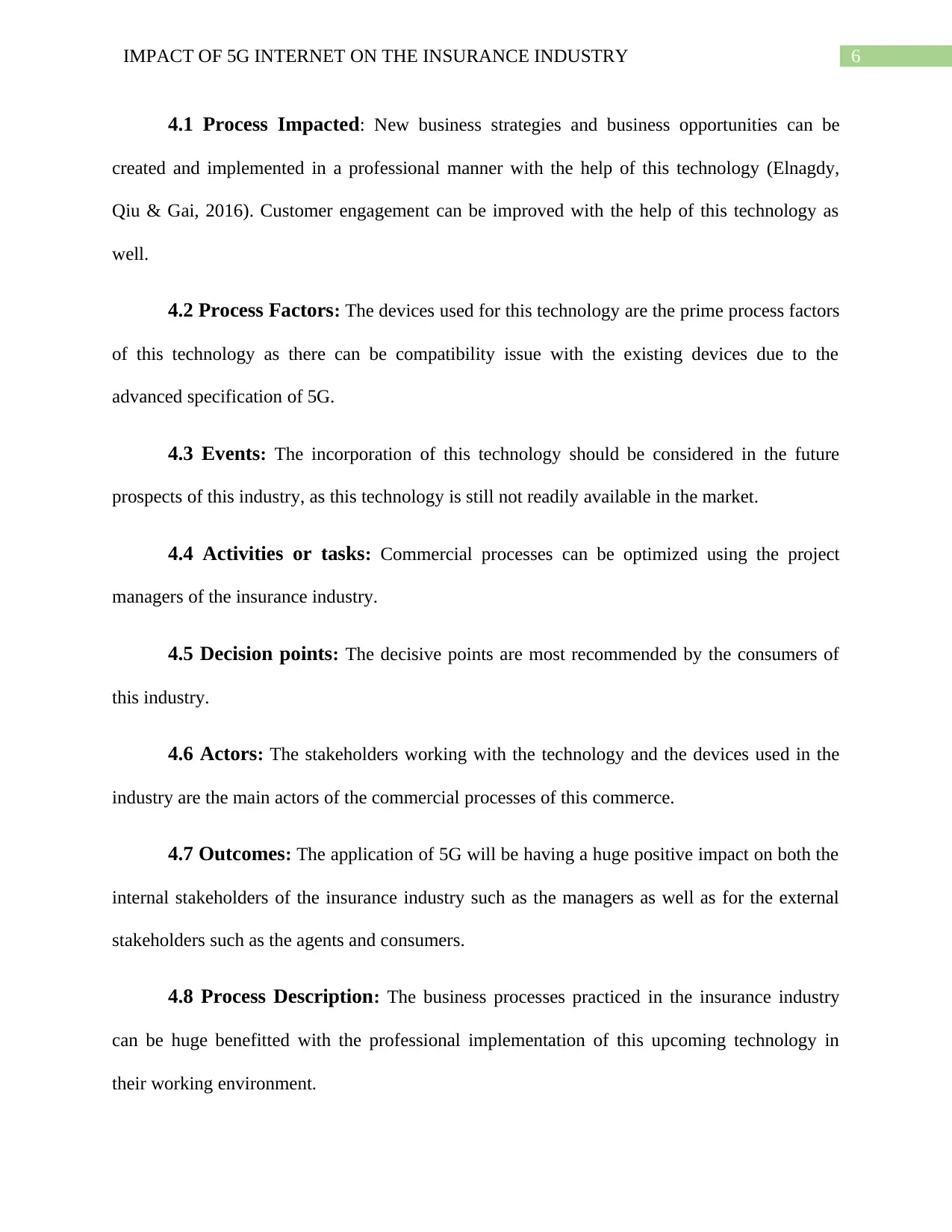
6IMPACT OF 5G INTERNET ON THE INSURANCE INDUSTRY
4.1 Process Impacted: New business strategies and business opportunities can be
created and implemented in a professional manner with the help of this technology (Elnagdy,
Qiu & Gai, 2016). Customer engagement can be improved with the help of this technology as
well.
4.2 Process Factors: The devices used for this technology are the prime process factors
of this technology as there can be compatibility issue with the existing devices due to the
advanced specification of 5G.
4.3 Events: The incorporation of this technology should be considered in the future
prospects of this industry, as this technology is still not readily available in the market.
4.4 Activities or tasks: Commercial processes can be optimized using the project
managers of the insurance industry.
4.5 Decision points: The decisive points are most recommended by the consumers of
this industry.
4.6 Actors: The stakeholders working with the technology and the devices used in the
industry are the main actors of the commercial processes of this commerce.
4.7 Outcomes: The application of 5G will be having a huge positive impact on both the
internal stakeholders of the insurance industry such as the managers as well as for the external
stakeholders such as the agents and consumers.
4.8 Process Description: The business processes practiced in the insurance industry
can be huge benefitted with the professional implementation of this upcoming technology in
their working environment.
4.1 Process Impacted: New business strategies and business opportunities can be
created and implemented in a professional manner with the help of this technology (Elnagdy,
Qiu & Gai, 2016). Customer engagement can be improved with the help of this technology as
well.
4.2 Process Factors: The devices used for this technology are the prime process factors
of this technology as there can be compatibility issue with the existing devices due to the
advanced specification of 5G.
4.3 Events: The incorporation of this technology should be considered in the future
prospects of this industry, as this technology is still not readily available in the market.
4.4 Activities or tasks: Commercial processes can be optimized using the project
managers of the insurance industry.
4.5 Decision points: The decisive points are most recommended by the consumers of
this industry.
4.6 Actors: The stakeholders working with the technology and the devices used in the
industry are the main actors of the commercial processes of this commerce.
4.7 Outcomes: The application of 5G will be having a huge positive impact on both the
internal stakeholders of the insurance industry such as the managers as well as for the external
stakeholders such as the agents and consumers.
4.8 Process Description: The business processes practiced in the insurance industry
can be huge benefitted with the professional implementation of this upcoming technology in
their working environment.
⊘ This is a preview!⊘
Do you want full access?
Subscribe today to unlock all pages.

Trusted by 1+ million students worldwide
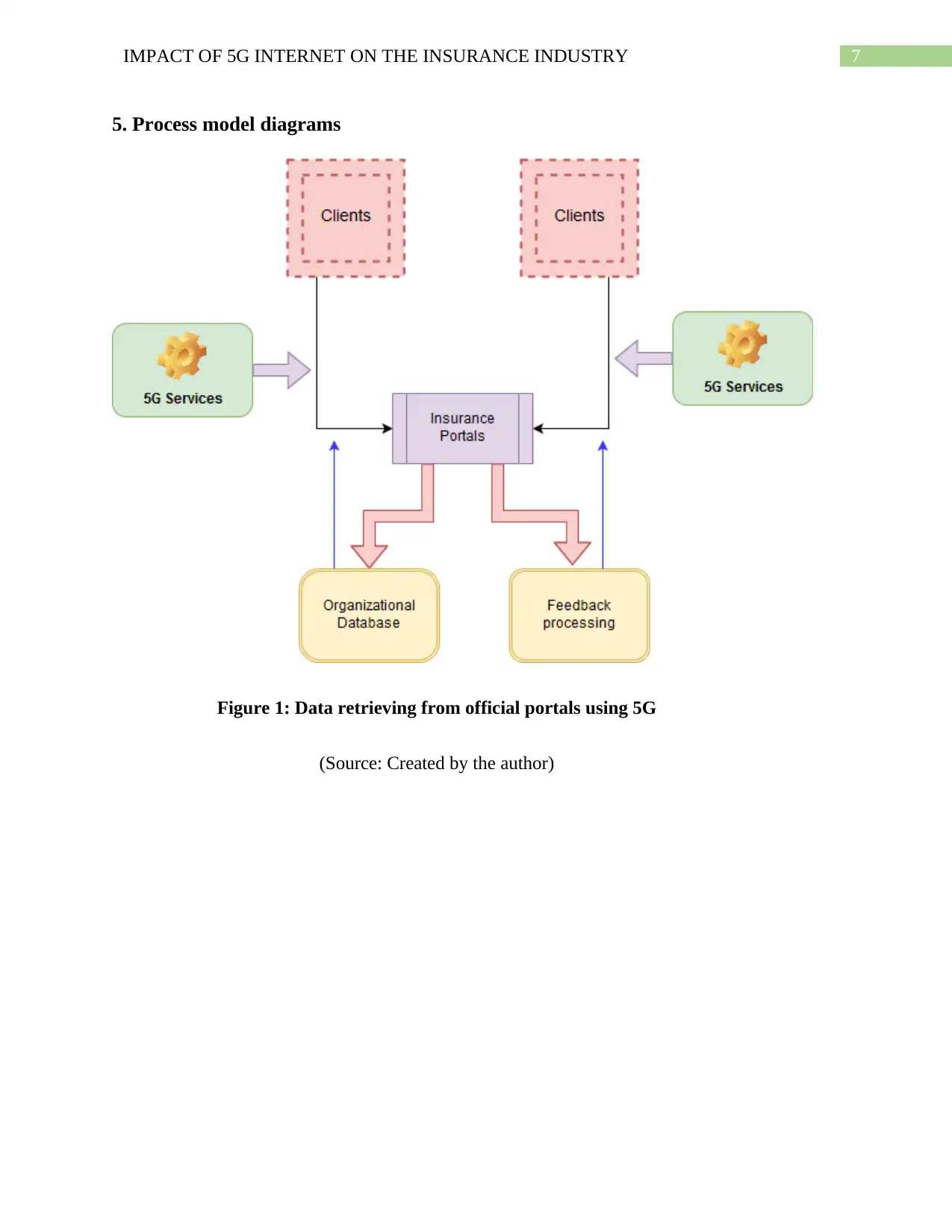
7IMPACT OF 5G INTERNET ON THE INSURANCE INDUSTRY
5. Process model diagrams
Figure 1: Data retrieving from official portals using 5G
(Source: Created by the author)
5. Process model diagrams
Figure 1: Data retrieving from official portals using 5G
(Source: Created by the author)
Paraphrase This Document
Need a fresh take? Get an instant paraphrase of this document with our AI Paraphraser
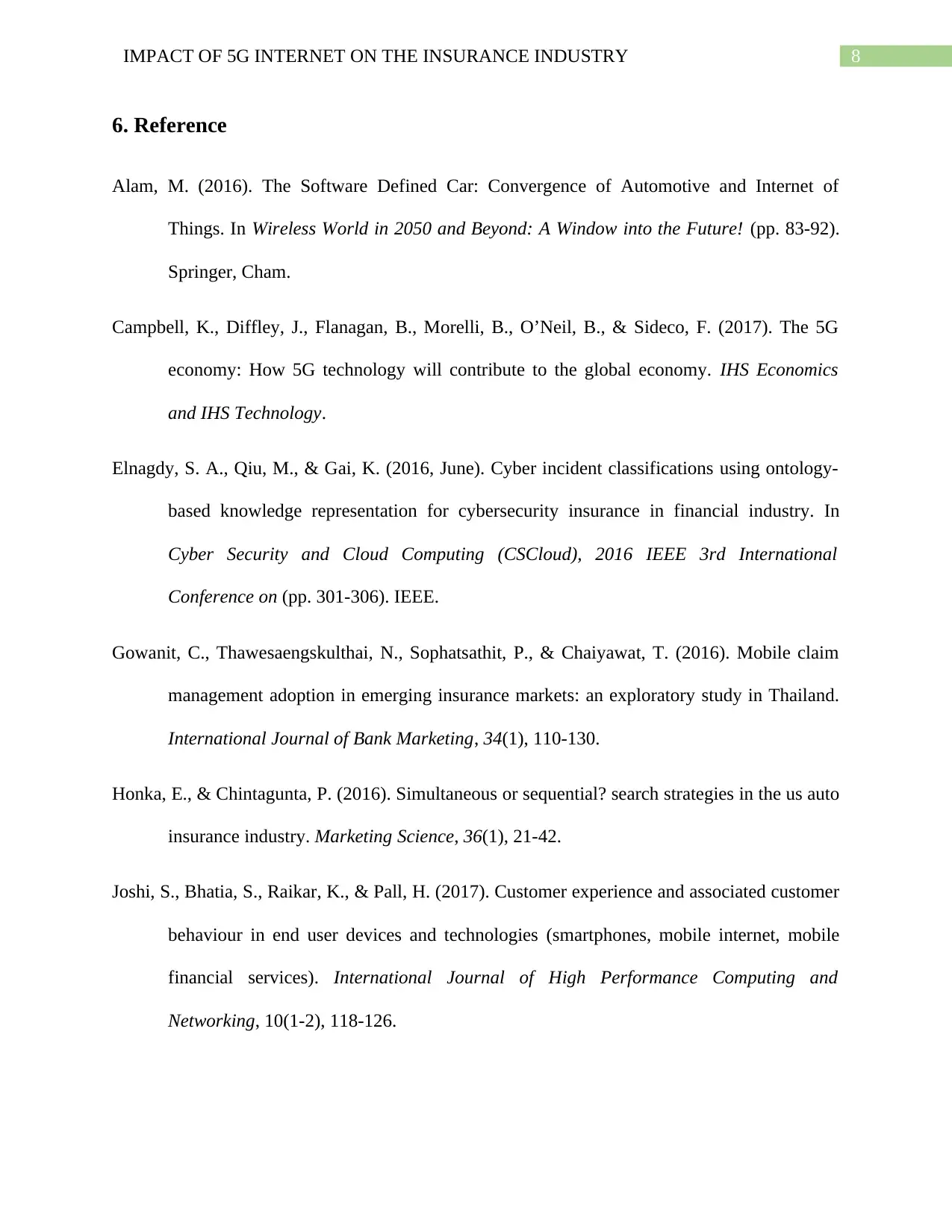
8IMPACT OF 5G INTERNET ON THE INSURANCE INDUSTRY
6. Reference
Alam, M. (2016). The Software Defined Car: Convergence of Automotive and Internet of
Things. In Wireless World in 2050 and Beyond: A Window into the Future! (pp. 83-92).
Springer, Cham.
Campbell, K., Diffley, J., Flanagan, B., Morelli, B., O’Neil, B., & Sideco, F. (2017). The 5G
economy: How 5G technology will contribute to the global economy. IHS Economics
and IHS Technology.
Elnagdy, S. A., Qiu, M., & Gai, K. (2016, June). Cyber incident classifications using ontology-
based knowledge representation for cybersecurity insurance in financial industry. In
Cyber Security and Cloud Computing (CSCloud), 2016 IEEE 3rd International
Conference on (pp. 301-306). IEEE.
Gowanit, C., Thawesaengskulthai, N., Sophatsathit, P., & Chaiyawat, T. (2016). Mobile claim
management adoption in emerging insurance markets: an exploratory study in Thailand.
International Journal of Bank Marketing, 34(1), 110-130.
Honka, E., & Chintagunta, P. (2016). Simultaneous or sequential? search strategies in the us auto
insurance industry. Marketing Science, 36(1), 21-42.
Joshi, S., Bhatia, S., Raikar, K., & Pall, H. (2017). Customer experience and associated customer
behaviour in end user devices and technologies (smartphones, mobile internet, mobile
financial services). International Journal of High Performance Computing and
Networking, 10(1-2), 118-126.
6. Reference
Alam, M. (2016). The Software Defined Car: Convergence of Automotive and Internet of
Things. In Wireless World in 2050 and Beyond: A Window into the Future! (pp. 83-92).
Springer, Cham.
Campbell, K., Diffley, J., Flanagan, B., Morelli, B., O’Neil, B., & Sideco, F. (2017). The 5G
economy: How 5G technology will contribute to the global economy. IHS Economics
and IHS Technology.
Elnagdy, S. A., Qiu, M., & Gai, K. (2016, June). Cyber incident classifications using ontology-
based knowledge representation for cybersecurity insurance in financial industry. In
Cyber Security and Cloud Computing (CSCloud), 2016 IEEE 3rd International
Conference on (pp. 301-306). IEEE.
Gowanit, C., Thawesaengskulthai, N., Sophatsathit, P., & Chaiyawat, T. (2016). Mobile claim
management adoption in emerging insurance markets: an exploratory study in Thailand.
International Journal of Bank Marketing, 34(1), 110-130.
Honka, E., & Chintagunta, P. (2016). Simultaneous or sequential? search strategies in the us auto
insurance industry. Marketing Science, 36(1), 21-42.
Joshi, S., Bhatia, S., Raikar, K., & Pall, H. (2017). Customer experience and associated customer
behaviour in end user devices and technologies (smartphones, mobile internet, mobile
financial services). International Journal of High Performance Computing and
Networking, 10(1-2), 118-126.
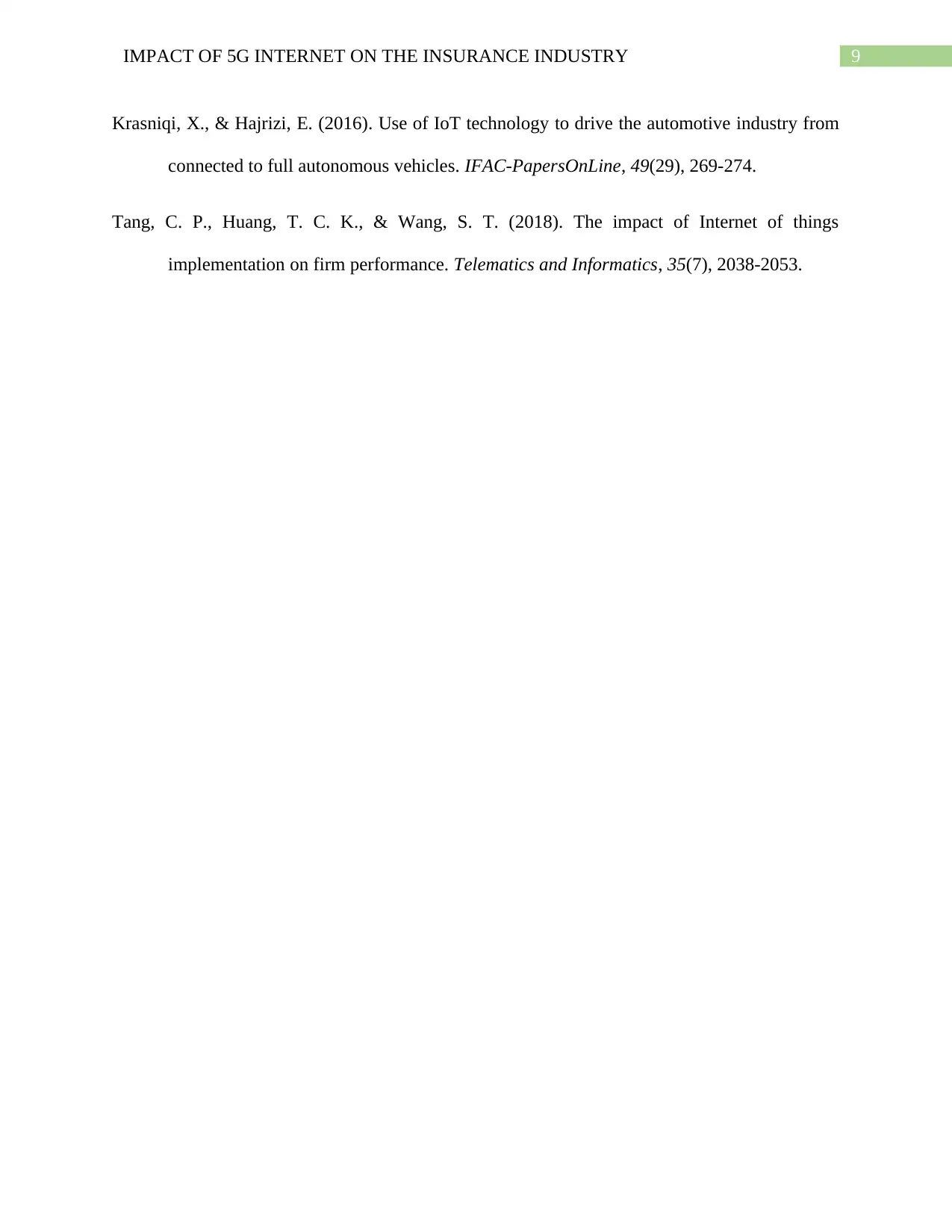
9IMPACT OF 5G INTERNET ON THE INSURANCE INDUSTRY
Krasniqi, X., & Hajrizi, E. (2016). Use of IoT technology to drive the automotive industry from
connected to full autonomous vehicles. IFAC-PapersOnLine, 49(29), 269-274.
Tang, C. P., Huang, T. C. K., & Wang, S. T. (2018). The impact of Internet of things
implementation on firm performance. Telematics and Informatics, 35(7), 2038-2053.
Krasniqi, X., & Hajrizi, E. (2016). Use of IoT technology to drive the automotive industry from
connected to full autonomous vehicles. IFAC-PapersOnLine, 49(29), 269-274.
Tang, C. P., Huang, T. C. K., & Wang, S. T. (2018). The impact of Internet of things
implementation on firm performance. Telematics and Informatics, 35(7), 2038-2053.
⊘ This is a preview!⊘
Do you want full access?
Subscribe today to unlock all pages.

Trusted by 1+ million students worldwide
1 out of 9
Related Documents
Your All-in-One AI-Powered Toolkit for Academic Success.
+13062052269
info@desklib.com
Available 24*7 on WhatsApp / Email
![[object Object]](/_next/static/media/star-bottom.7253800d.svg)
Unlock your academic potential
Copyright © 2020–2025 A2Z Services. All Rights Reserved. Developed and managed by ZUCOL.




